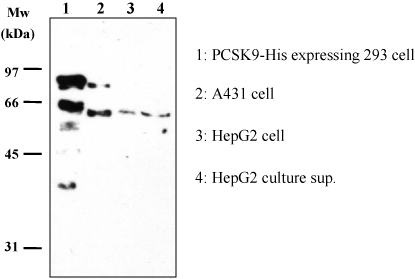Anti-PCSK9 (Human) mAb
| Code | Size | Price |
|---|
| MBL-CY-M1033 | 100 ug | £415.00 |
Quantity:
Prices exclude any Taxes / VAT
Overview
Host Type: Mouse
Antibody Isotype: IgG1
Antibody Clonality: Monoclonal
Antibody Clone: KS-4H12
Regulatory Status: RUO
Target Species: Human
Applications:
- Immunoprecipitation (IP)
- Western Blot (WB)
Shipping:
4°C
Storage:
-20°C
Images
Documents
Further Information
Applications:
WB - 0.5-1 ug/mL IP - 1-2 ug/sample
Background:
PCSK9 (also known as neural apoptosis-regulated convertase, NARC-1) is a 692-residue extracellular protein expressed primarily in the kidneys, liver and intestines (1) representing the 9th member of the secretory subtilase family. Various genetic observations subsequently mapped PCSK9 as the third gene (along with LDLR and APOB) to cause autosomal dominant hypercholesterolemia (ADH). These studies suggested that gain of function mutations increase plasma levels of LDL-c (2?6), whereas nonsense or missense (loss-of-function) mutations, which interfere with folding or secretion of PCSK9, lead to a reduction of plasma levels of LDL-c and an 88% decrease in the risk of coronary heart disease (CHD) (5). In mice, adenoviral overexpression of PCSK9 results in increased plasma LDL-c level in normal mice but not in LDLR-deficient mice (7). Deletion of PCSK9 causes an increase in level of LDLR protein but not mRNA (8). These findings lead to a hypothesis that PCSK9 exerts its role in cholesterol metabolism through posttranslational down-regulation of LDLR, the receptor responsible for clearing LDL-c from plasma.
Evidence is consistent with the secreted form of PCSK9 binding directly to the LDLR and resulting in degradation of the receptor (9, 10). Zhang et al. (11) localized the binding site of PCSK9 in the LDLR to the first epidermal growth factor-like repeat (EGF-A) of the extracellular domain and showed that PCSK9 binding to this site is required for LDLR degradation. In light of these observations and the fact that PCSK9 in the circulation may cause the degradation of hepatic LDLR in the liver, PCSK9 would seem to be an attractive drug target for lowering LDLC.
Concentration:
1.0 mg/mL
Formulation:
Supplied in 20mM phosphatase buffer (pH 7.5), 300mM NaCl, 50% glycerol.
Gene IDs:
Human: 255738 Mouse: 100102
Immunogen Translated:
Cells were expressed in 293 His-tagged Human PCSK9 (full length)
MW:
62-66 kDa
Shelf Life:
1 year
Source:
Monoclonal antibody is produced by immunizing mice with a His-tagged- PCSK9, corresponding full length of human PCSK9, expressed in 293 cells. IgG is purified by protein A-Sepharose chromatography.
Target:
PCSK9
References
1. Seidah NG, Benjannet S, Wickham L, Marcinkiewicz J, Jasmin SB, Stifani S, Basak A, Prat A, Chretien M (2003) Proc Natl Acad Sci USA 100: 928-933.
2. Abifadel M, Varret M, Rabes JP, Allard D, Ouguerram K, Devillers M, Cruaud C, Benjannet S, Wickham L, Erlich D, et al. (2003) Nat Genet 34: 154-156.
3. Leren TP (2004) Clin Genet 65: 419-422.
4. Allard D, Amsellem S, Abifadel M, Trillard M, Devillers M, Luc G, Krempf M, Reznik Y, Girardet JP, Fredenrich A, et al. (2005) Hum Mutat 26: 497.
5. Cohen JC, Boerwinkle E, Mosley TH, Jr, Hobbs HH (2006) N Engl J Med 354: 1264-1272.
6. Berge KE, Ose L, Leren TP (2006) Arterioscler Thromb Vasc Biol 26: 1094-1100.
7. Maxwell KN, Breslow JL (2004) Proc Natl Acad Sci USA 101: 7100-7105.
8. Rashid S, Curtis DE, Garuti R, Anderson NN, Bashmakov Y, Ho YK, Hammer RE, Moon YA, Horton JD (2005) Proc Natl Acad Sci USA 102: 5374-5379.
9. Lagace, T. A., Curtis, D. E., Garuti, R., McNutt, M. C., Park, S. W., Prather, H. B., Anderson, N. N., Ho, Y. K., Hammer, R. E., and Horton, J. D. (2006) J. Clin. Investig. 116: 2995-3005
10. Cameron, J., Holla, O. L., Ranheim, T., Kulseth, M. A., Berge, K. E., and Leren, T. P. (2006) Hum. Mol. Genet. 15: 1551-1558
11. Zhang, D. W., Lagace, T. A., Garuti, R., Zhao, Z., McDonald, M., Horton, J. D., Cohen, J. C., and Hobbs, H. H. (2007) J. Biol. Chem. 282: 18602-18612



